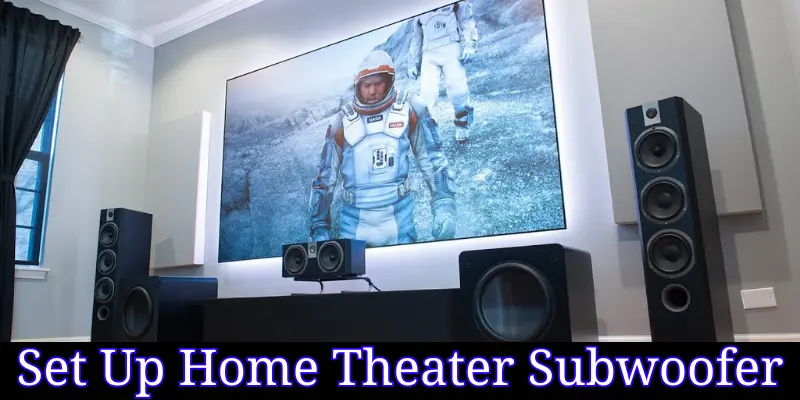
Welcome to the world of deep, resonating bass! As a music enthusiast, I understand a subwoofer enclosure’s crucial role in enhancing your sound experience.
In this guide, we’ll dive into the heart of bass production – the subwoofer enclosure. Whether setting up your home theater or upgrading your car’s audio system, choosing the right enclosure is key to achieving that deep, powerful bass we love.
From understanding different enclosure types to matching them with your space, I’m here to help you navigate this sonic journey. Let’s explore how to choose the right subwoofer enclosure for deep bass.
Understanding Subwoofer Enclosures
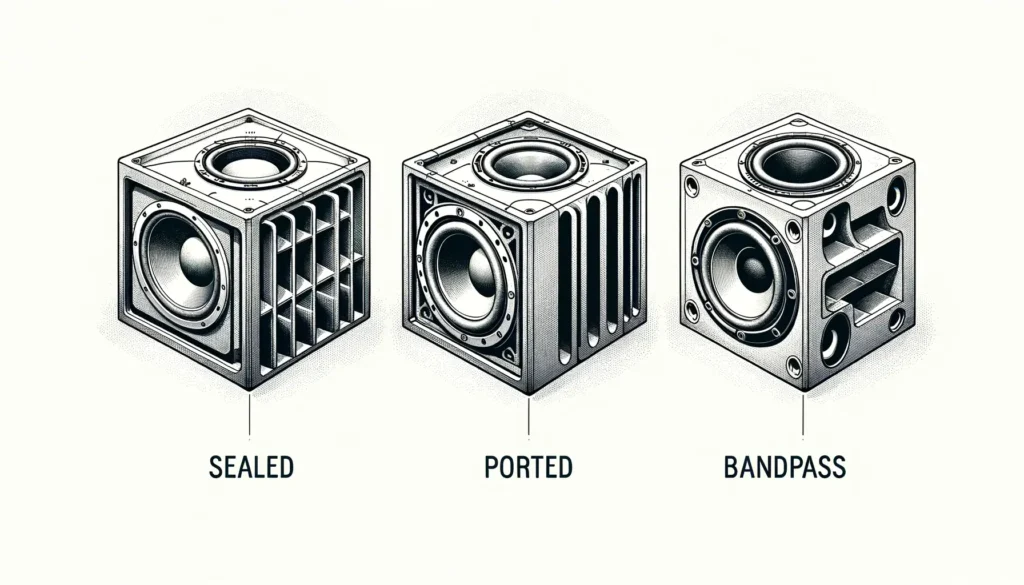
Have you ever wondered what makes the ‘boom’ in your favorite songs feel so alive? That’s where a subwoofer enclosure comes in! It’s like a house for your subwoofer, a special kind of speaker that loves to play deep sounds, like the low notes in music.
Now, let’s talk about the different types of houses or enclosures for your subwoofer. Each type has its own special way of making sounds.
Sealed Enclosures:
Imagine a box tightly closed on all sides. This is a sealed enclosure. It’s great for clear and accurate bass. The bass sounds very clean and tight when you listen to music with a sealed enclosure. It’s like hearing someone play a big drum very clearly.
Ported Enclosures:
These enclosures have a special hole or ‘port’ that lets air move in and out. This design helps to make the bass sound louder and more powerful. If you love feeling the thump in your chest when you hear music, a ported enclosure might be what you need.
Bandpass Enclosures:
Consider these as a cool mix of sealed and ported. They have two chambers, with the subwoofer in the middle. One side is sealed, and the other has a port. Bandpass enclosures can make some bass notes really stand out. It’s like having a spotlight that shines only on certain sounds.
Each type of enclosure has its own special way of bringing out the best in your music. Whether you like your bass to sound super clean or really booming, there’s an enclosure just for you!
Factors Affecting Subwoofer Enclosure Performance

When we pick the perfect enclosure for our subwoofer, a few things really matter. It’s like choosing a room for your music to live in! Let’s look at what makes a subwoofer enclosure perform at its best.
Size and Volume of the Enclosure:
Think of the enclosure’s size as a playground. If it’s too small, the bass can’t play freely. But if it’s too big, the bass might get lost. We need just the right size to let the bass sound its best.
Imagine a basketball in a room. If the room is too tiny, the ball can’t bounce far. But in a room that’s just right, it bounces perfectly!
Material and Build Quality:
The stuff your enclosure is made of is super important. Good materials mean better sound. It’s like wearing a cozy jacket on a cold day; the right material keeps you warm. In the same way, a well-built enclosure made from strong, quality materials helps to produce clean, crisp bass.
The Role of Enclosure Design in Sound Quality:
The enclosure’s design is like a secret recipe. It decides how your music will sound. Some designs make the bass deep and powerful, while others make it light and precise.
It’s all about matching the design to what you love in music. Think of it like building a sandcastle. The shape and design of the castle decide how it looks. Similarly, the design of the enclosure shapes how your music sounds.
Remember, these factors are like pieces of a puzzle. When they fit together just right, your music sounds amazing!
How to Choose the Right Subwoofer Enclosure for Deep Bass?

Picking the right subwoofer enclosure for that awesome deep bass is like choosing the best shoes for a marathon – you need the perfect fit! Let’s compare different enclosure types and see their pros and cons for deep bass production.
Sealed Enclosures for Deep Bass:
- Pros: These give you a precise and clean bass. It’s like a well-timed drum beat that doesn’t echo.
- Cons: They might not give you the loudest bass. Think of them as a whisper, not a shout.
Ported Enclosures for Deep Bass:
- Pros: Want to feel the bass vibrate in your chest? Ported enclosures deliver that powerful, booming bass. It’s like the roar of a lion!
- Cons: They’re bigger and need more space. Also, the bass might not be as tight or accurate as sealed enclosures.
Bandpass Enclosures for Deep Bass:
- Pros: These are like a spotlight on specific bass notes, making them stand out. It’s great for certain types of music where you want some bass notes to boom.
- Cons: They’re not very versatile. It’s like having a flashlight that only shines on one spot.
Each type of enclosure brings its own flavor to the music. Think about what kind of bass makes your heart beat faster. Do you like it deep and resonating or tight and precise? Remember, the best choice depends on your personal taste and the kind of music you love!
Compatibility with Your Subwoofer and Room

When we’re on the quest of how to choose the right subwoofer enclosure for deep bass, it’s like finding a dance partner for your subwoofer. They need to move together in perfect harmony!
Matching the Enclosure with Your Subwoofer Model:
Your subwoofer and its enclosure must fit just right. Think of it like a puzzle piece – each model has its unique fit. Check your subwoofer’s specifications; they’ll tell you what it needs. It’s like reading a recipe before you start cooking – you want to ensure you have the right ingredients!
Considering Room Size and Acoustics:
The room where you place your subwoofer is like its stage. Big rooms might need a louder, ported enclosure to fill the space with sound, just like a singer needs a microphone in a large hall. A sealed enclosure might be perfect for that tight, clear bass in smaller rooms.
Acoustics are also key. If you have lots of furniture and carpets, they absorb sound, kind of like how a sponge absorbs water. A room with hard surfaces and less furniture might make the bass sound louder and more echoey.
Remember, the goal is to create a beautiful sound dance between your subwoofer, its enclosure, and the room. When these three are in sync, the deep bass you experience will be just right – powerful, clear, and immersive!
Custom vs. Pre-built Enclosures
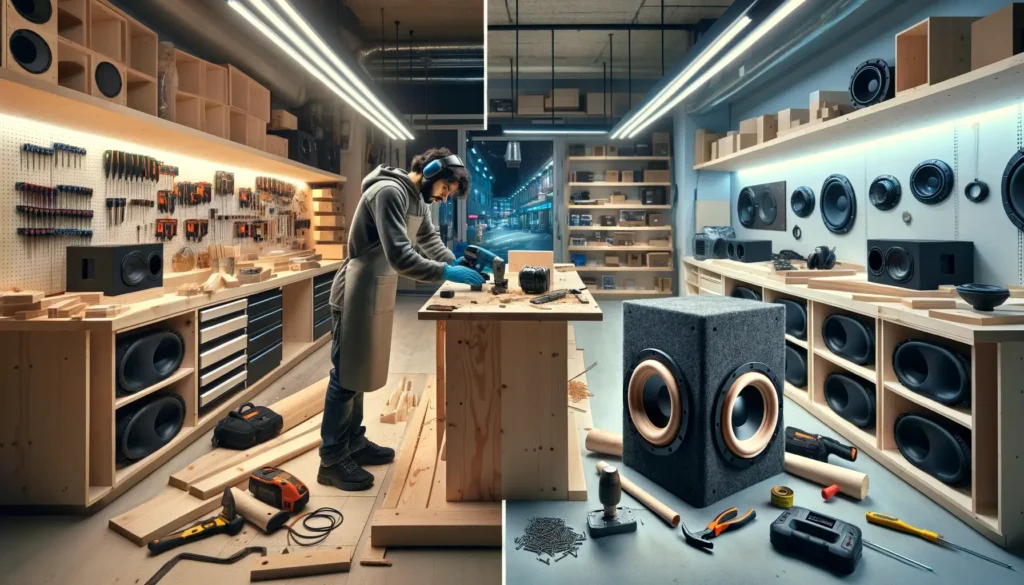
When diving into choosing the right subwoofer enclosure for deep bass, one big decision is whether to go custom-built or pre-built. It’s like deciding between baking a cake from scratch or buying one from the store.
Custom-Built Enclosures:
- Benefits: Custom enclosures are like tailor-made suits; they fit your specific needs perfectly. You can choose the size, material, and design that suits your subwoofer and room. It’s a great choice if you want something unique or have a specific sound goal.
- Drawbacks: However, building your own enclosure requires time, tools, and a bit of know-how. It’s like making a cake – you need the right recipe and skills to get it right.
Pre-built Enclosures:
- Benefits: Pre-built enclosures are convenient – like a cake to enjoy. Experts design them in various styles and sizes, making finding a good match for your subwoofer easier.
- Drawbacks: The downside is that you might not find the perfect fit for your unique setup, like buying a suit off the rack.
Tips for DIY Enthusiasts:
- If you want to build your own enclosure, start by researching and planning.
- Think about the size and type of enclosure that will work best for your space and subwoofer.
- Gather all the tools and materials you need before you start.
And most importantly, have fun with it! It’s a great project for those who love a hands-on approach to their audio setup.
Remember, whether you choose custom-built or pre-built, the goal is to enhance your listening experience with deep, rich bass. Choose the path that feels right for you, and enjoy the journey of creating your ideal sound space!
Installation and Setup Tips
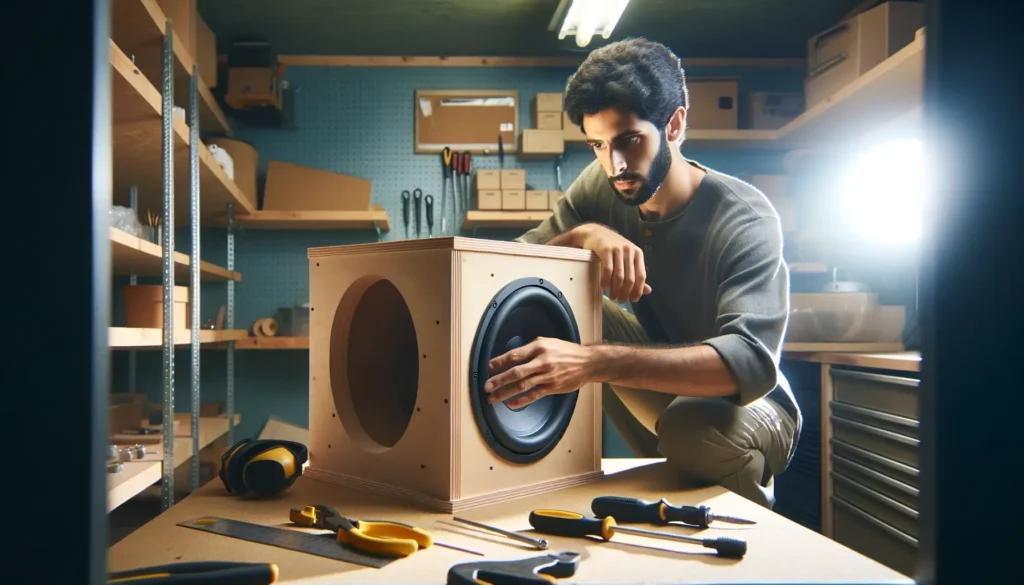
Getting your subwoofer enclosure set up for that deep, mesmerizing bass is exciting. Here are some tips to ensure you get the best out of your setup. Remember, if you need a complete guide on installation, check out our detailed guide already on the site!
Best Practices for Installing the Subwoofer in the Enclosure:
- Ensure a Secure Fit: Ensure your subwoofer fits snugly in the enclosure. It’s like putting the last piece in a puzzle – it should fit just right.
- Check the Wiring: Proper wiring is key. It’s like ensuring all the lights are connected properly in a Christmas tree.
- Seal It Tight: If using a sealed enclosure, ensure all the edges are perfectly sealed. It’s like closing all the windows in your house on a windy day.
Tips for Optimizing Placement for the Best Bass Response:
- Avoid Corners: Placing the subwoofer in a corner can sometimes muddy the bass. It’s like trying to talk in a crowded room.
- Experiment with Positioning: Move your subwoofer around the room. It’s like finding the sweet spot where you’re most comfortable in your bed.
- Consider Room Acoustics: Every room is different, like each person’s voice. The room’s size and shape affect how the bass sounds.
These tips are a starting point to help you get great bass from your setup. For more in-depth information, don’t forget to check out our complete guide on installing a subwoofer enclosure for deep bass. Happy listening!
Maintaining Your Subwoofer Enclosure
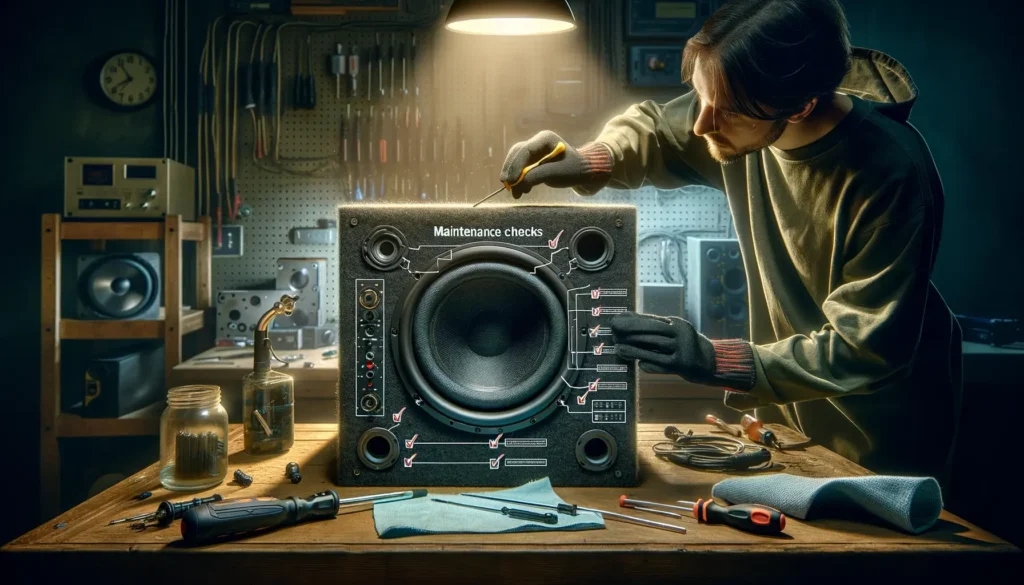
Keeping your subwoofer enclosure tip-top shape is key to enjoying that deep, rich bass for years. Let’s walk through some basic maintenance tips.
And remember, for more detailed insights on getting the best deep bass from your subwoofer, check out our complete guide already available on the site!
Basic Maintenance Tips for Longevity and Performance:
- Regular Cleaning: Just like dusting your shelves, keep your enclosure clean. A gentle wipe with a dry cloth is often enough.
- Check for Wear and Tear: Periodically inspect for any signs of damage or wear, like you would check your shoes for holes.
- Tighten Connections: Make sure all screws and connections stay tight – it’s like making sure the buttons on your coat are securely sewn.
When to Consider Upgrading or Replacing Your Enclosure:
- Changing Audio Needs: If your taste in music or your space changes, like when you move from a small room to a bigger one, it might be time to upgrade.
- Wear and Tear: Just like replacing a well-loved pair of sneakers, consider a replacement if your enclosure shows significant wear.
- Advancements in Technology: Keep an eye on new developments. Sometimes, an upgrade can bring exciting new features, like getting a new phone with the latest technology.
For those looking to dive deeper into maximizing their bass experience, don’t forget to check out our comprehensive guide on how to get deep bass from your subwoofer. It’s full of useful tips and tricks!
FAQs
Which subwoofer box is best for deep bass?
For the deepest bass, a ported enclosure is usually your best bet. It’s like having a megaphone for your bass – it amplifies and deepens the sound. But remember, the ‘best’ box also depends on your personal taste and the type of music you enjoy!
What size subwoofer is best for deep bass?
Larger subwoofers, typically those 12 inches or more, are great for deep bass. They’re like big drums, able to hit those low notes better. But make sure your space can handle it – bigger isn’t always better in a small room!
How do I know what size subwoofer enclosure I need?
The size of your enclosure should match your subwoofer’s specifications. It’s like finding the right size shoes for your feet. Check the manufacturer’s recommendations to get the perfect fit for the best sound.
What happens if a sub-enclosure is too small?
If your enclosure is too small, it can limit the movement of the subwoofer, like trying to dance in a cramped space. This can lead to weaker bass and sometimes even damage your subwoofer. You want enough room for the bass to ‘breathe’ and resonate properly.
Conclusion
As we wrap up our journey on how to choose the right subwoofer enclosure for deep bass, remember it’s all about finding what resonates with you and your space.
Whether you opt for a sealed, ported, or bandpass enclosure, the right choice balances your subwoofer’s capabilities with your room’s acoustics.
Don’t be afraid to experiment a little. Sometimes, the best sound setup is found through trial and error. And if you’re curious about boosting your bass without a subwoofer, check out our guide on “how to increase bass in the car without a subwoofer.” It’s full of helpful tips for even more audio adventures.
Finally, our guide on how to build a subwoofer box for deep bass is a great next step for those eager to get hands-on. Building your own enclosure can be a rewarding experience, offering a deeper understanding and connection to your music.
Thank you for joining me on this sonic journey. Remember, the perfect bass experience is just a few thoughtful choices away!

